InSARTrac Field Tests—Combining Computer Vision and Terrestrial InSAR for 3D Displacement Monitoring
Abstract
1. Introduction
2. Monitoring and Analysis Methods
2.1. Study Site and Monitoring Concept
2.2. InSARTrac Setup and Analysis
2.3. UAV Mapping and Analysis
3. Results
3.1. Measurement System
3.2. Total Displacements
3.3. Daily Displacement Patterns
3.4. Differential Elevation Models
4. Discussion
4.1. Measurement System
4.2. Measurement Results
4.3. Beneficial Effects of 3D Surface Monitoring
5. Conclusions
Author Contributions
Funding
Data Availability Statement
Acknowledgments
Conflicts of Interest
References
- Pieraccini, M.; Miccinesi, L. Ground-Based Radar Interferometry: A Bibliographic Review. Remote Sens. 2019, 11, 1029. [Google Scholar] [CrossRef]
- Fuhrmann, T.; Garthwaite, M.C. Resolving Three-Dimensional Surface Motion with InSAR: Constraints from Multi-Geometry Data Fusion. Remote Sens. 2019, 11, 241. [Google Scholar] [CrossRef]
- Eriksen, H.Ø.; Bergh, S.G.; Larsen, Y.; Skrede, I.; Kristensen, L.; Lauknes, T.R.; Blikra, L.H.; Kierulf, H.P. Relating 3D surface displacement from satellite- and ground-based InSAR to structures and geomorphology of the Jettan rockslide, northern Norway. NJG 2017, 97, 283–303. [Google Scholar] [CrossRef]
- Hu, J.; Li, Z.W.; Ding, X.L.; Zhu, J.J.; Zhang, L.; Sun, Q. Resolving three-dimensional surface displacements from InSAR measurements: A review. Earth-Sci. Rev. 2014, 133, 1–17. [Google Scholar] [CrossRef]
- Tong, X.; Liu, S.; Li, R.; Xie, H.; Liu, S.; Qiao, G.; Feng, T.; Tian, Y.; Ye, Z. Multi-track extraction of two-dimensional surface velocity by the combined use of differential and multiple-aperture InSAR in the Amery Ice Shelf, East Antarctica. Remote Sens. Environ. 2018, 204, 122–137. [Google Scholar] [CrossRef]
- Delacourt, C.; Allemand, P.; Berthier, E.; Raucoules, D.; Casson, B.; Grandjean, P.; Pambrun, C.; Varel, E. Remote-sensing techniques for analysing landslide kinematics: A review. Bull. De La Société Géologique De Fr. 2007, 178, 89–100. [Google Scholar] [CrossRef]
- Casson, B.; Delacourt, C.; Allemand, P. Contribution of multi-temporal remote sensing images to characterize landslide slip surface — Application to the La Clapière landslide (France). Nat. Hazards Earth Syst. Sci. 2005, 5, 425–437. [Google Scholar] [CrossRef]
- Lacroix, P.; Berthier, E.; Maquerhua, E.T. Earthquake-driven acceleration of slow-moving landslides in the Colca valley, Peru, detected from Pléiades images. Remote Sens. Environ. 2015, 165, 148–158. [Google Scholar] [CrossRef]
- Travelletti, J.; Delacourt, C.; Allemand, P.; Malet, J.-P.; Schmittbuhl, J.; Toussaint, R.; Bastard, M. Correlation of multi-temporal ground-based optical images for landslide monitoring: Application, potential and limitations. ISPRS J. Photogramm. Remote Sens. 2012, 70, 39–55. [Google Scholar] [CrossRef]
- Bickel, V.; Manconi, A.; Amann, F. Quantitative Assessment of Digital Image Correlation Methods to Detect and Monitor Surface Displacements of Large Slope Instabilities. Remote Sens. 2018, 10, 865. [Google Scholar] [CrossRef]
- Kuang, J.; Ng, A.H.-M.; Ge, L.; Metternicht, G.I.; Clark, S.R. Joint Use of Optical and Radar Remote Sensing Data for Characterizing the 2020 Aniangzhai Landslide Post-Failure Displacement. Remote Sens. 2023, 15, 369. [Google Scholar] [CrossRef]
- Zambanini, C.; Kieffer, D.S.; Lienhart, W.; Woschitz, H. InSARTrac: A novel approach for remote acquisition of 3D slope displacement vectors. IOP Conf. Ser. Earth Environ. Sci. 2021, 833, 12148. [Google Scholar] [CrossRef]
- Zambanini, C.; Kieffer, D.S.; Woschitz, H.; Lienhart, W. Hybrid InSARTrac for Remote Geostructure Monitoring; American Society of Civil Engineers: Reston, VA, USA, 2022; Available online: https://ascelibrary.org/doi/book/10.1061/9780784484067 (accessed on 12 December 2022).
- IDS GeoRadar. Available online: https://idsgeoradar.com/products/interferometric-radar/hydra-g (accessed on 12 December 2022).
- Zambanini, C.; Kieffer, D.S. Hybrid InSARTrac for monitoring interglacial movement patterns. IOP Conf. Ser. Earth Environ. Sci. 2023, 1124, 12028. [Google Scholar] [CrossRef]
- Lieb, G.K.; Kellerer-Pirklbauer, A. Gletscherbericht 2019/20 Sammelbericht über die Gletschermessungen des Österreichischen Alpenvereins im Jahr 2020. Letzter Bericht: Bergauf 2/2020. 2020. Available online: https://www.alpenverein.at/portal_wAssets/docs/service/presse/2021/gletscherbericht/Alpenverein_Bergauf-2-21_Gletscherbericht.pdf (accessed on 9 January 2023).
- Lieb, G.K.; Kellerer-Pirklbauer, A. Gletscherbericht 2020/21 Sammelbericht über die Gletschermessungen des Österreichischen Alpenvereins im Jahre 2021. 2022. Available online: https://www.alpenverein.at/portal_wAssets/docs/service/presse/2022/gletscherbericht/Bergauf_Gletscherbericht-2020_21.pdf (accessed on 7 January 2023).
- Haiden, T.; Kann, A.; Wittmann, C.; Pistotnik, G.; Bica, B.; Gruber, C. The Integrated Nowcasting through Comprehensive Analysis (INCA) System and Its Validation over the Eastern Alpine Region. Weather Forecast. 2011, 26, 166–183. [Google Scholar] [CrossRef]
- Pech-Pacheco, J.L.; Cristobal, G.; Chamorro-Martinez, J.; Fernandez-Valdivia, J. Diatom autofocusing in brightfield microscopy: A comparative study. In Proceedings of the 15th International Conference on Pattern Recognition, ICPR-2000, Barcelona, Spain, 3–7 September 2000; Volume 3, pp. 314–317, ISBN 1051-4651. [Google Scholar]
- Zuiderveld, K. Contrast Limited Adaptive Histogram Equalization. Graph. Gems 1990, 1, 474–485. [Google Scholar] [CrossRef]
- Fischler, A.M.; Bolles, C.R. Random sample consensus: A paradigm for model fitting with applications to image analysis and automated cartography. Commun. ACM 1981, 24, 381–395. [Google Scholar] [CrossRef]
- Ferretti, A.; Prati, C.; Rocca, F. Permanent scatterers in SAR interferometry. IEEE Trans. Geosci. Remote Sens. 2001, 39, 8–20. [Google Scholar] [CrossRef]
- IDS GeoRadar. IBIS Guardian. Available online: https://idsgeoradar.com/products/software/guardian (accessed on 5 May 2022).
- Crosetto, M.; Monserrat, O.; Cuevas-González, M.; Devanthéry, N.; Crippa, B. Persistent Scatterer Interferometry: A review. ISPRS J. Photogramm. Remote Sens. 2016, 115, 78–89. [Google Scholar] [CrossRef]
- Da-Jiang Innovations Science and Technology Co., Ltd. L1 Operation Guidebook; Da-Jiang Innovations Science and Technology Co., Ltd.: Shenzhen, China, 2022. [Google Scholar]
- Da-Jiang Innovations Science and Technology Co., Ltd. DJI Terra. Da-Jiang Innovations Science and Technology Co., Ltd.: Shenzhen, China, 2022. [Google Scholar]
- CloudCompare. 2022. Available online: https://en.wikipedia.org/wiki/CloudCompare (accessed on 7 January 2023).
- Cleveland, W.S. Robust Locally Weighted Regression and Smoothing Scatterplots. J. Am. Stat. Assoc. 1979, 74, 829–836. [Google Scholar] [CrossRef]
- Dai, X.; Khorram, S. The effects of image misregistration on the accuracy of remotely sensed change detection. IEEE Trans. Geosci. Remote Sens. 1998, 36, 1566–1577. [Google Scholar] [CrossRef]
- Kellerer-pirklbauer, A.; Lieb, G.K.; Avian, M.; Gspurning, J. The response of partially debris-covered valley glaciers to climate change: The example of the pasterze glacier (austria) in the period 1964 to 2006. Geogr. Ann. Ser. A Phys. Geogr. 2008, 90, 269–285. [Google Scholar] [CrossRef]
- Liu, L.; Jiang, L.; Sun, Y.; Wang, H.; Sun, Y.; Xu, H. Diurnal fluctuations of glacier surface velocity observed with terrestrial radar interferometry at Laohugou No. 12 Glacier, western Qilian mountains, China. J. Glaciol. 2019, 65, 239–248. [Google Scholar] [CrossRef]
- Hock, R. Glacier melt: A review of processes and their modelling. Prog. Phys. Geogr. Earth Environ. 2005, 29, 362–391. [Google Scholar] [CrossRef]

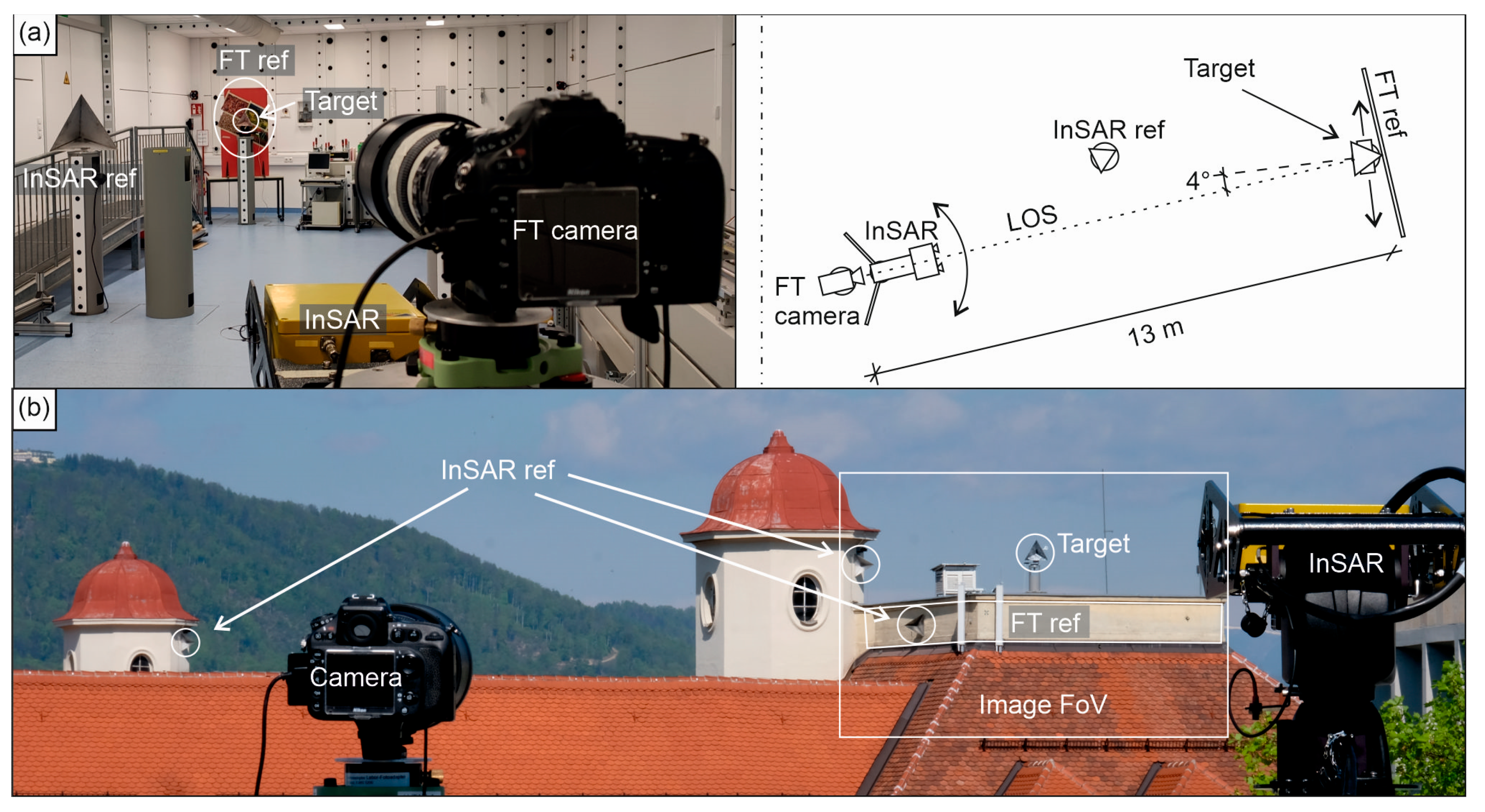
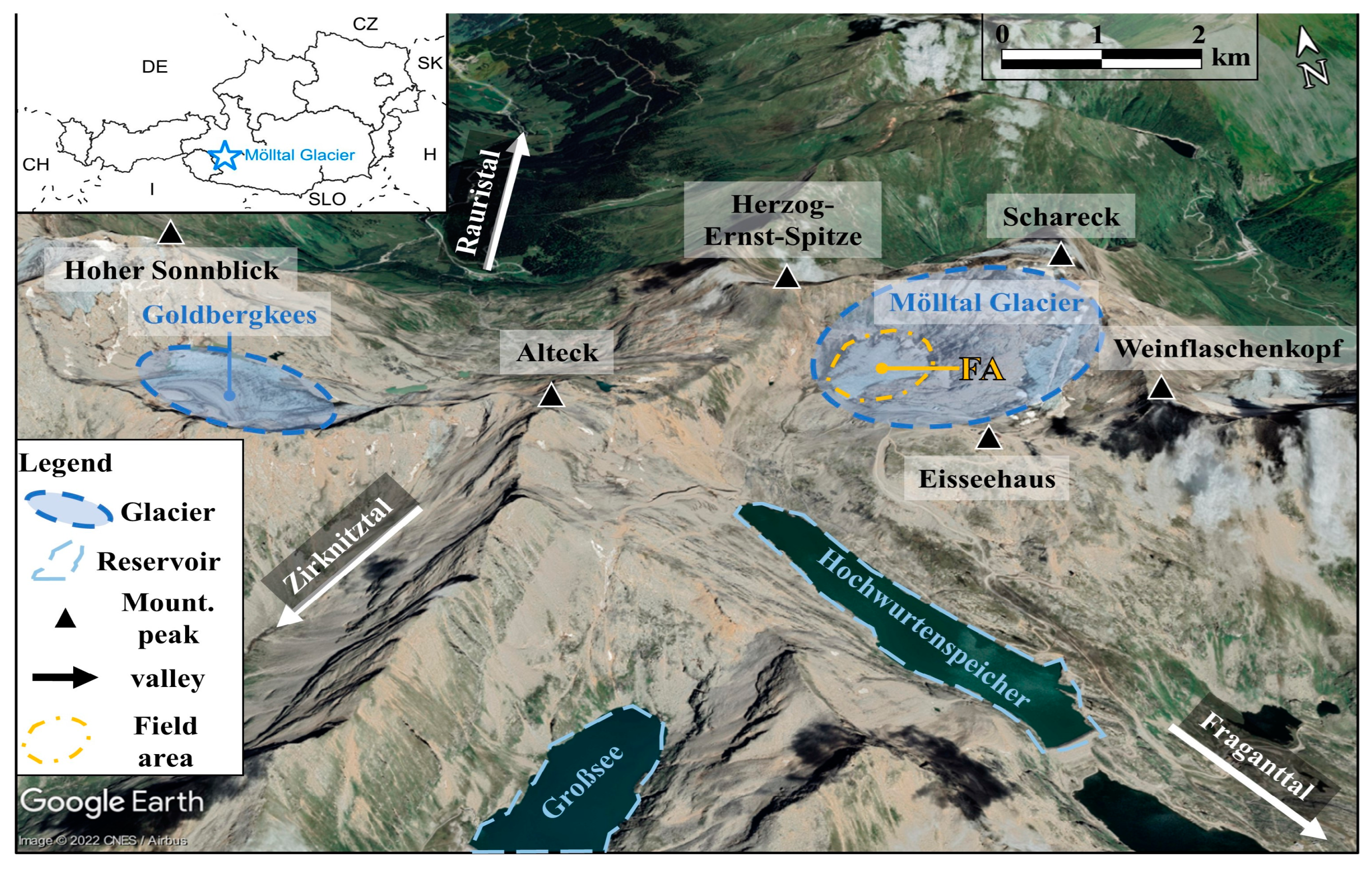
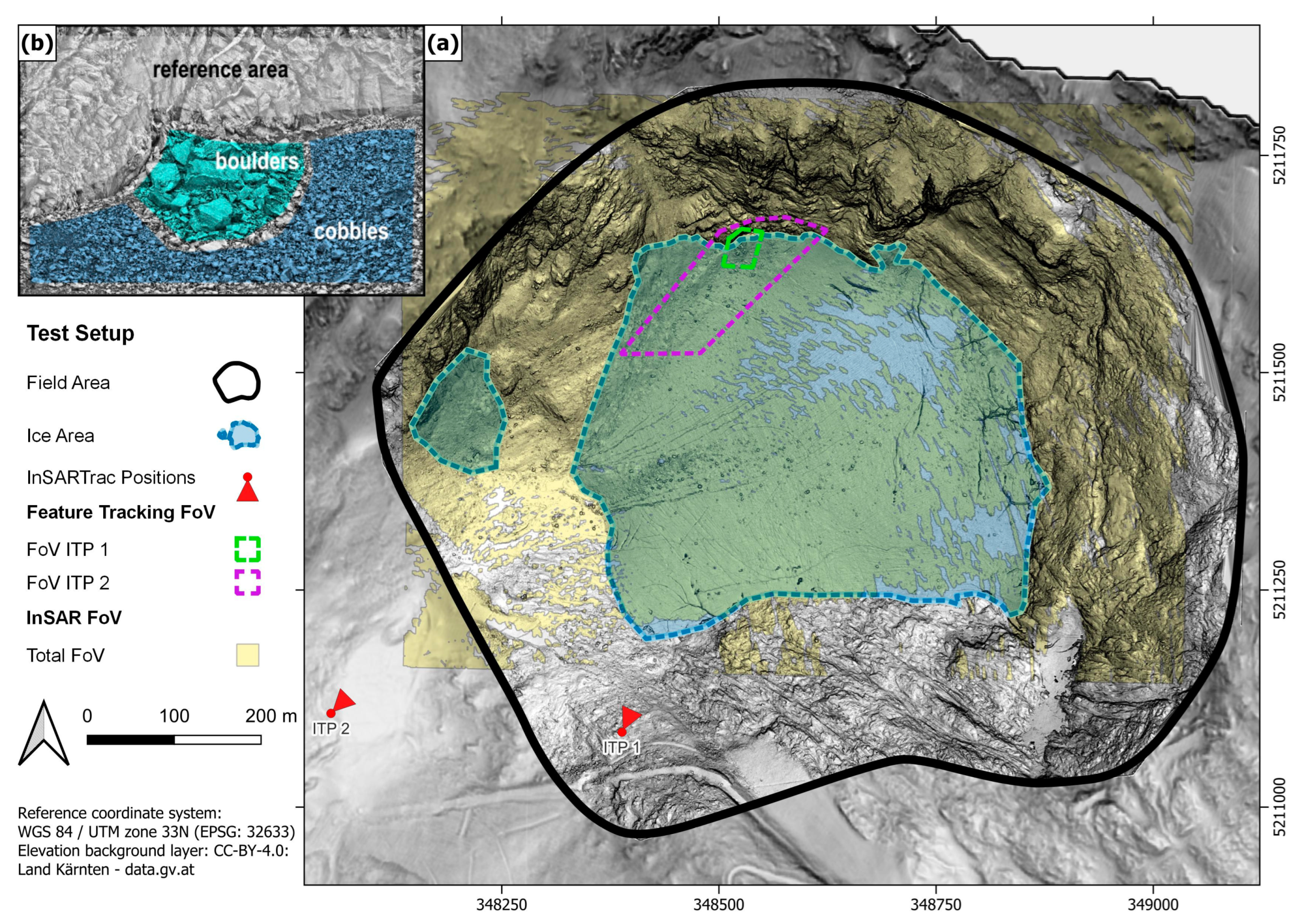

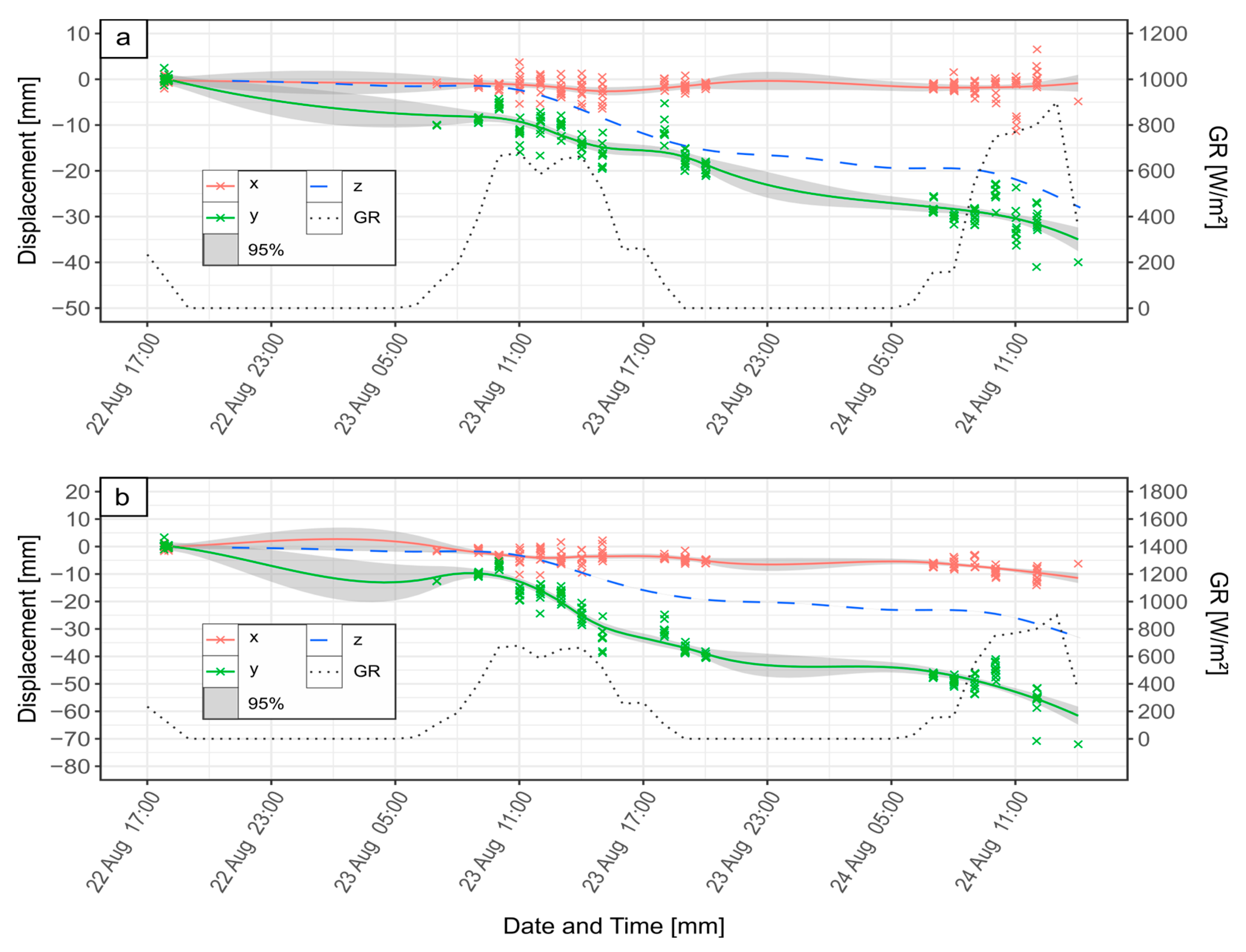
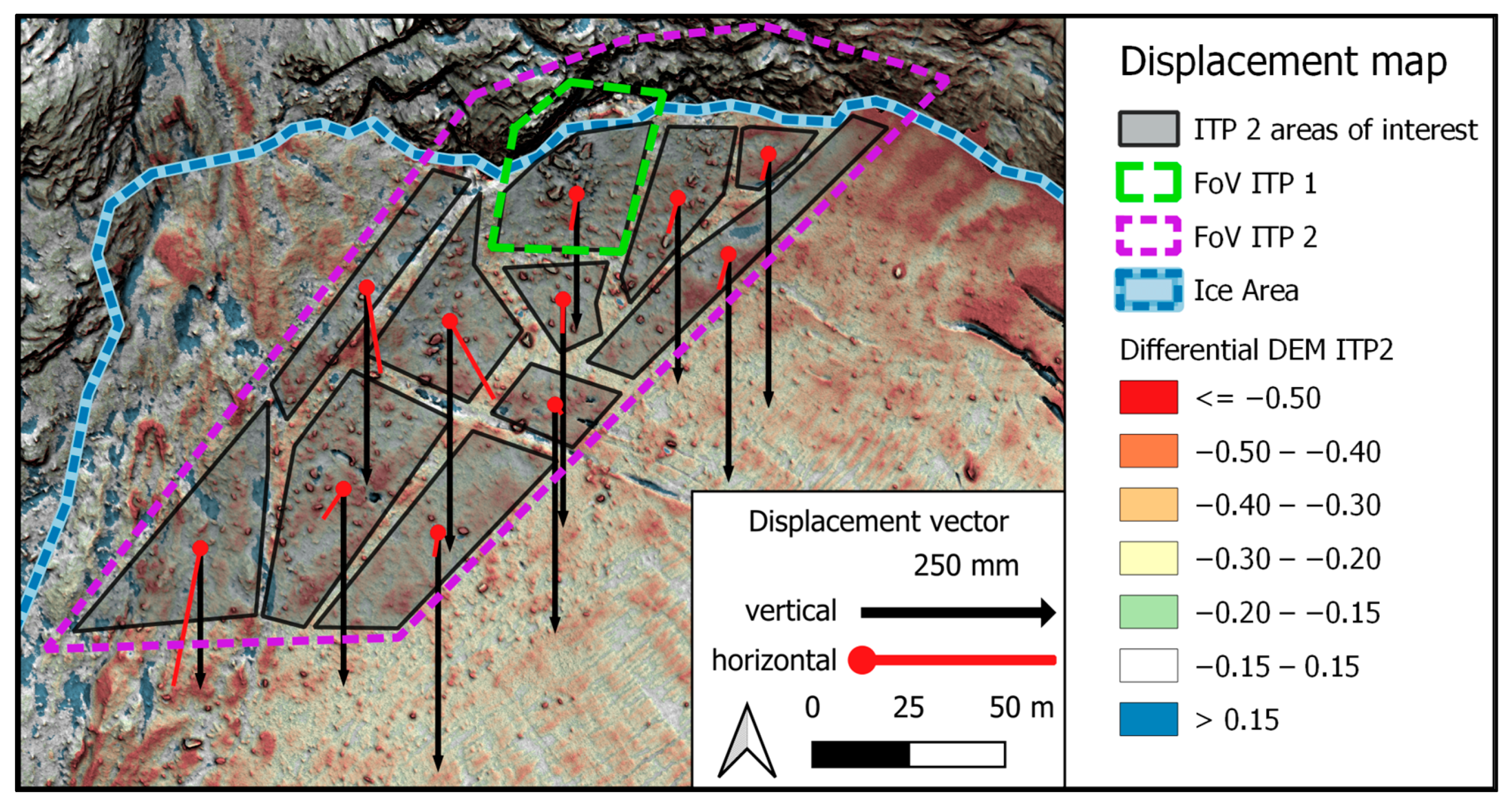

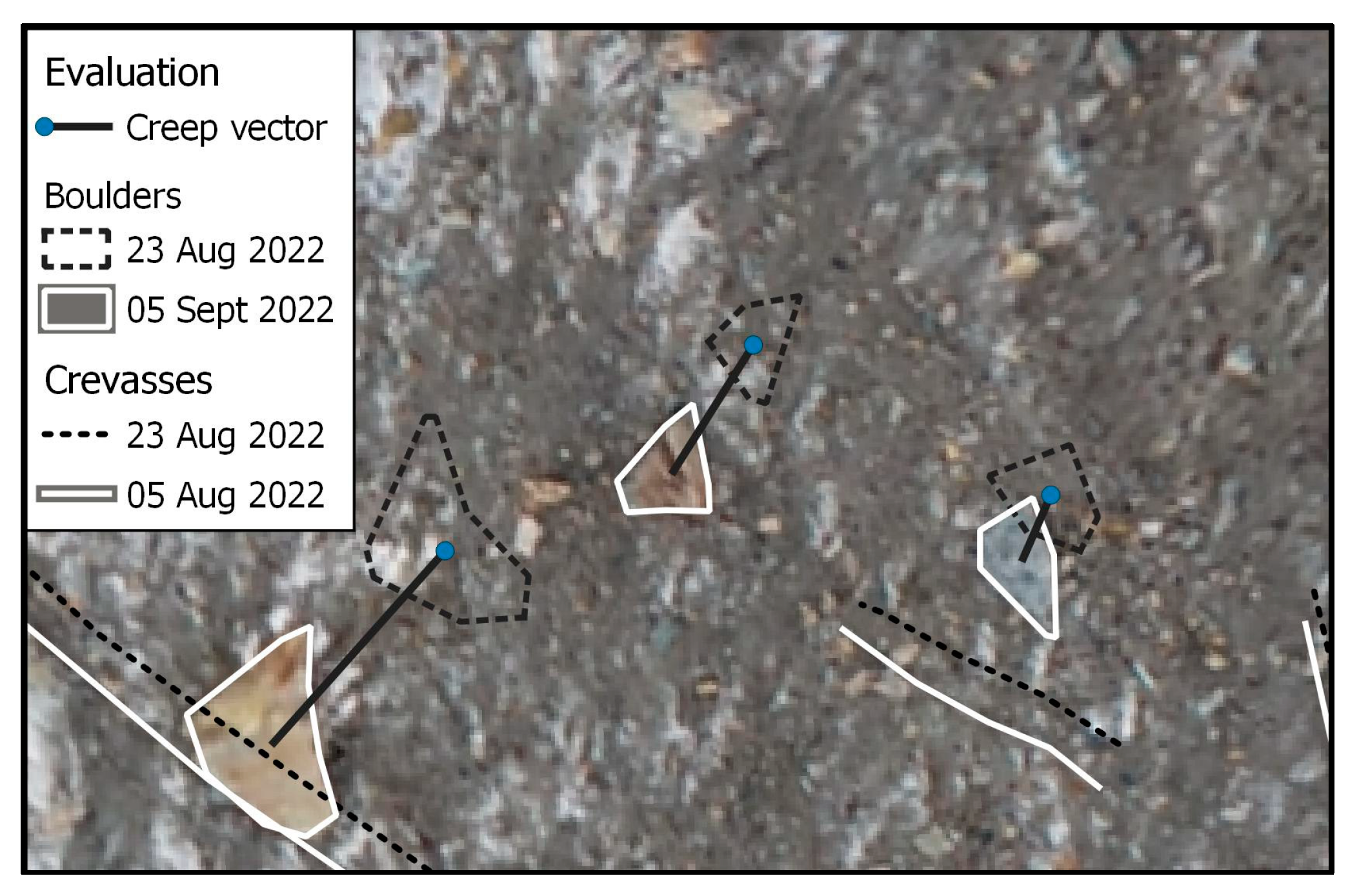
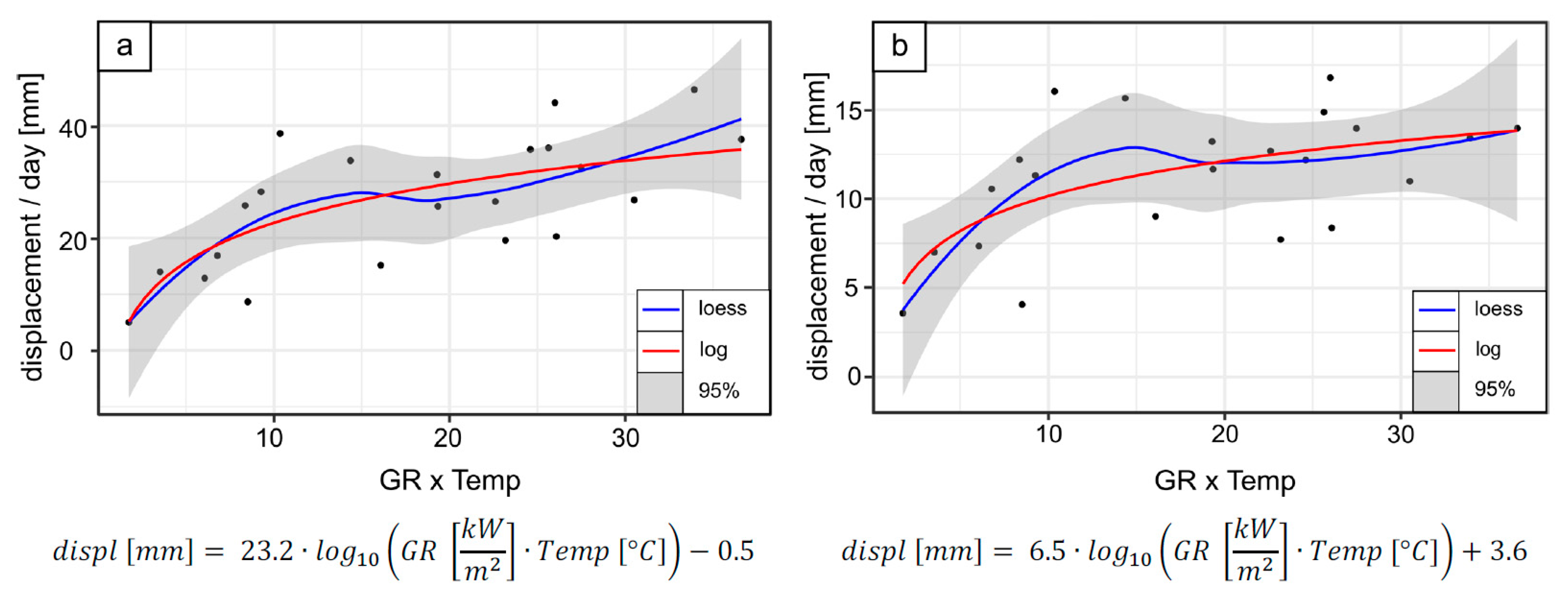
| Position | Area of Interest | x [mm] (mm/Day) | y [mm] (mm/Day) | z [mm] (mm/Day) |
| 1 | Boulders | −15 (−1.1) | −185 (−13.2) | −202 (−14.4) |
| 1 | Cobbles | −42 (−3.0) | −341 (−24.4) | −207 (−14.8) |
| 2 | Boulders | −14 (−1.75) | −123 (−15.4) | −44 (−5.5) |
| 2 | Cobbles | −27 (−3.4) | −172 (−21.5) | −67 (−8.4) |
| Position | Area of interest | East [mm] (mm/day) | North [mm] (mm/day) | Height [mm] (mm/day) |
| 1 | Boulders | −29 (−2.1) | −179 (−12.8) | −205 (−14.6) |
| 1 | Cobbles | −2 (−0.1) | −174 (−12.4) | −362 (−25.9) |
| 2 | Boulders | −4 (−0.5) | −25 (−3.1) | −129 (−16.1) |
| 2 | Cobbles | −4 (−0.5) | −43 (−5.4) | −181 (−22.6) |
| Area | ITP 1 | ITP 2 | Total | |||
|---|---|---|---|---|---|---|
| 23 August 2022–5 September 2022 | 5 September 2022–22 September 2022 | 23 August 2022–22 September 2022 | ||||
| z [mm] (mm/Day) | σ [mm] | z [mm] (mm/Day) | σ [mm] | z [mm] (mm/Day) | σ [mm] | |
| Global | −600 (−46) | 210 | −276 (−16) | 280 | −880 (−29) | 370 |
| FoV ITP 1 | −352 (−27) | 510 | −51 (−3) | 143 | −550 (−18) | 628 |
| FoV ITP 2 | −480 (−37) | 300 | −253 (−15) | 504 | −753 (−25) | 398 |
| Boulders | −176 (−14) | 323 | −165 (−10) | 230 | −341 (−11) | 362 |
| Cobbles | −365 (−28) | 190 | −197 (−12) | 143 | −562 (−19) | 226 |
| Ice Surface Gradient | Resultant Vector Gradient | Total Displ [mm] (mm/Day) | Melting [mm] (mm/Day) | Displacement Parallel to Ice Surface Gradientl [mm] (mm/Day) | |
|---|---|---|---|---|---|
| Boulders | 42° | 58° | 393 (17.1) | 148 (6.4) | 278 (12.1) |
| Cobbles | 33° | 68° | 585 (25.4) | 402 (17.5) | 259 (11.3) |
| Boulders [2] | 33° | 58° | 393 (17.1) | 200 (8.7) | 246 (10.7) |
Disclaimer/Publisher’s Note: The statements, opinions and data contained in all publications are solely those of the individual author(s) and contributor(s) and not of MDPI and/or the editor(s). MDPI and/or the editor(s) disclaim responsibility for any injury to people or property resulting from any ideas, methods, instructions or products referred to in the content. |
© 2023 by the authors. Licensee MDPI, Basel, Switzerland. This article is an open access article distributed under the terms and conditions of the Creative Commons Attribution (CC BY) license (https://creativecommons.org/licenses/by/4.0/).
Share and Cite
Zambanini, C.; Reinprecht, V.; Kieffer, D.S. InSARTrac Field Tests—Combining Computer Vision and Terrestrial InSAR for 3D Displacement Monitoring. Remote Sens. 2023, 15, 2031. https://doi.org/10.3390/rs15082031
Zambanini C, Reinprecht V, Kieffer DS. InSARTrac Field Tests—Combining Computer Vision and Terrestrial InSAR for 3D Displacement Monitoring. Remote Sensing. 2023; 15(8):2031. https://doi.org/10.3390/rs15082031
Chicago/Turabian StyleZambanini, Christoph, Volker Reinprecht, and Daniel Scott Kieffer. 2023. "InSARTrac Field Tests—Combining Computer Vision and Terrestrial InSAR for 3D Displacement Monitoring" Remote Sensing 15, no. 8: 2031. https://doi.org/10.3390/rs15082031
APA StyleZambanini, C., Reinprecht, V., & Kieffer, D. S. (2023). InSARTrac Field Tests—Combining Computer Vision and Terrestrial InSAR for 3D Displacement Monitoring. Remote Sensing, 15(8), 2031. https://doi.org/10.3390/rs15082031






